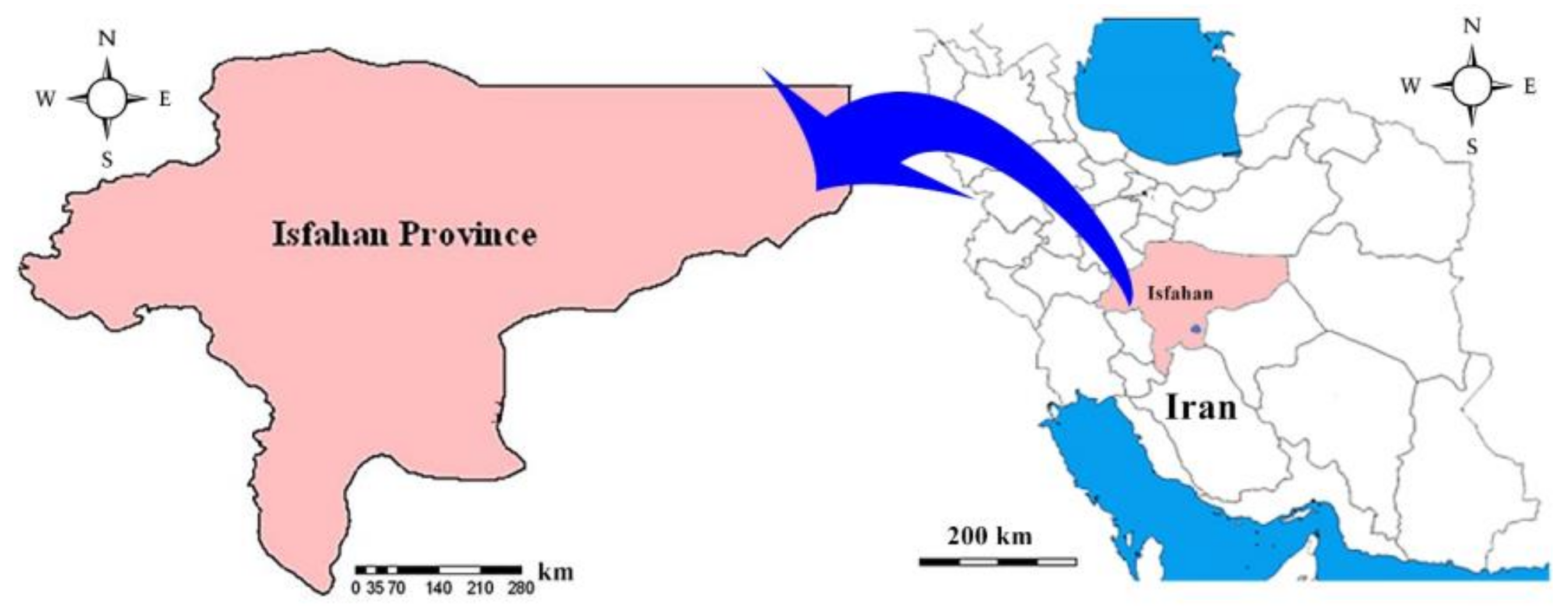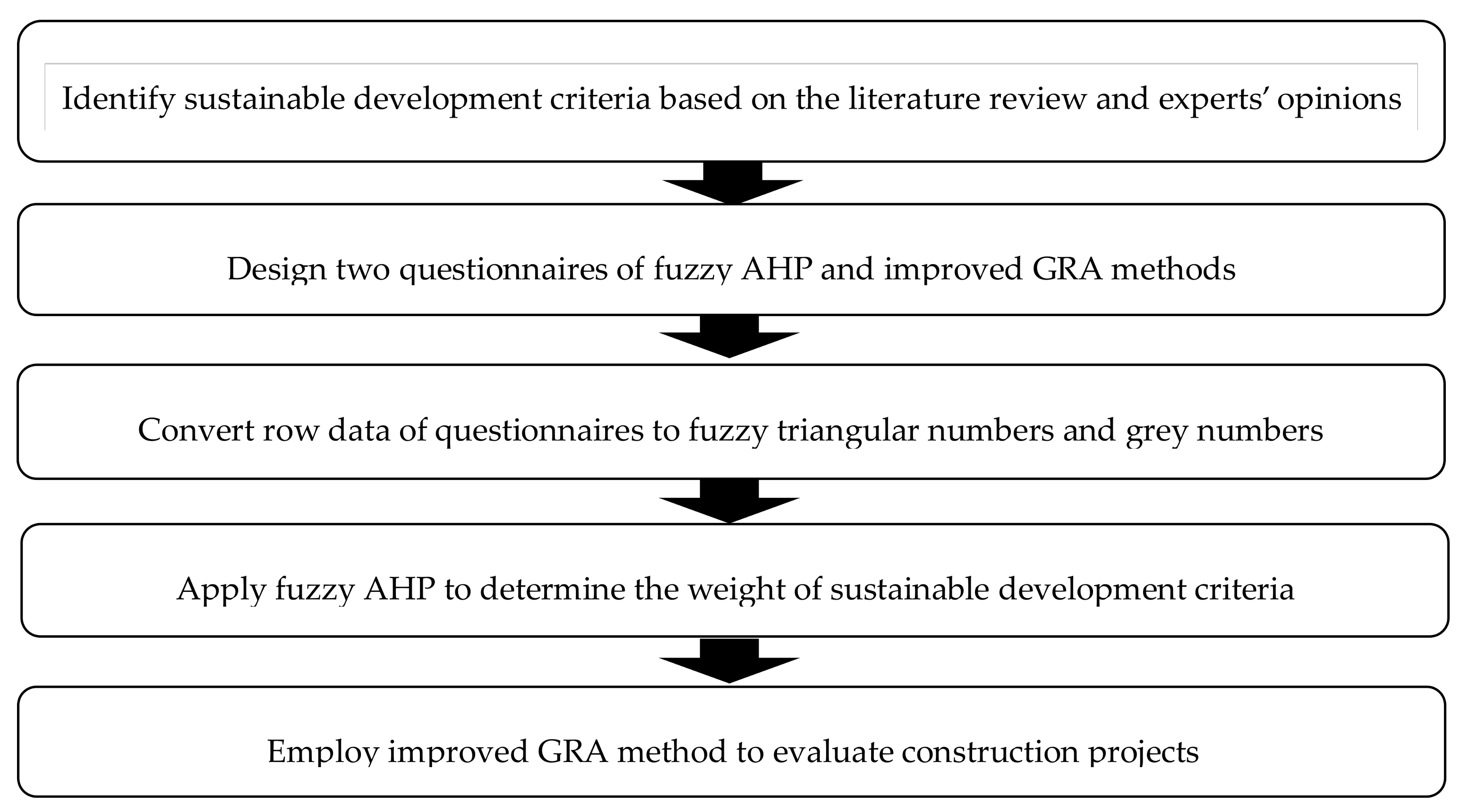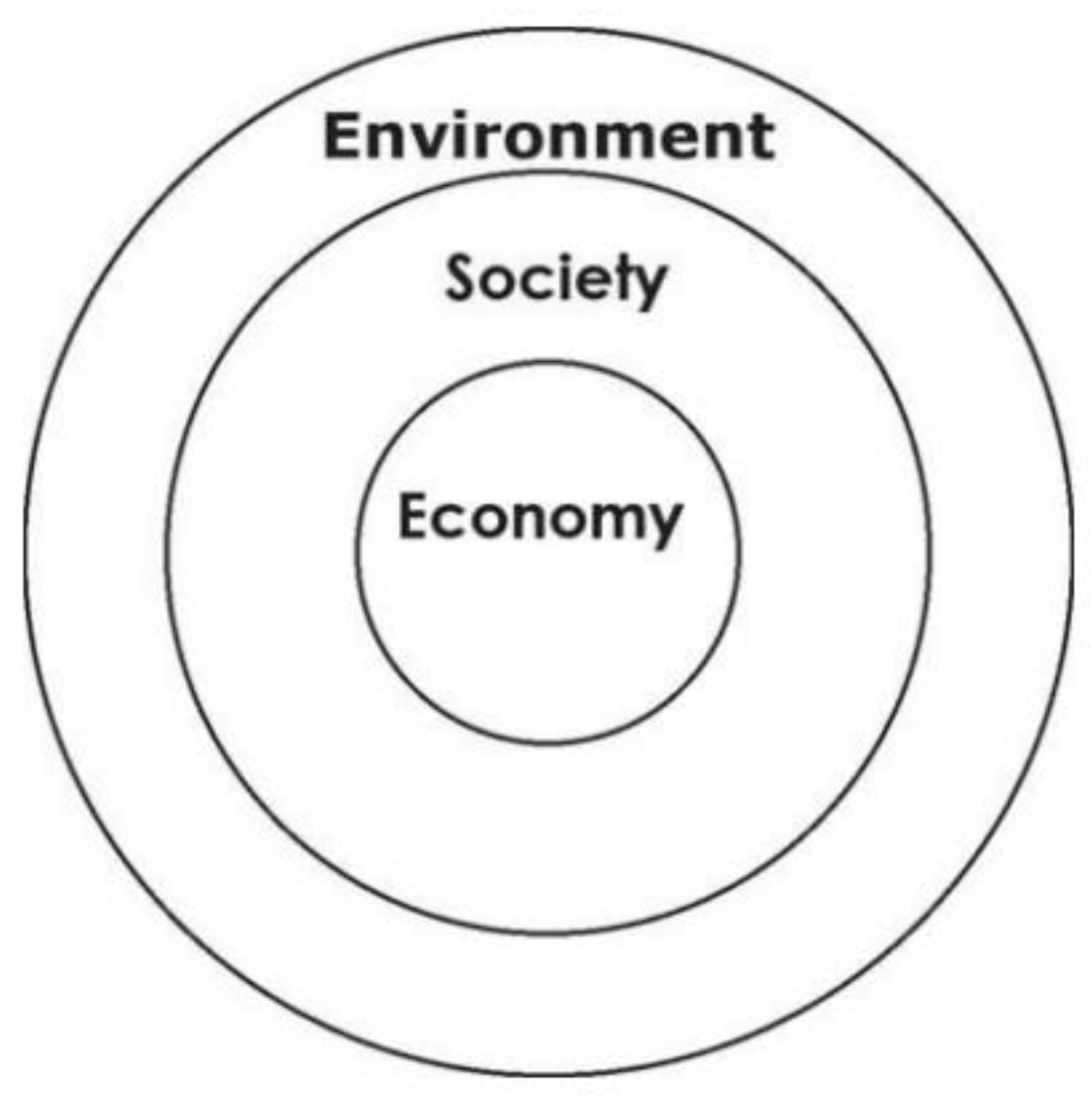Construction Projects Assessment Based on the Sustainable Development Criteria by an Integrated Fuzzy AHP and Improved GRA Model
Abstract
:1. Introduction
- (1)
- Reducing, by half, the number of people who do not have access to water until 2015,
- (2)
- Minimizing chemical materials harmful for human health and nature until 2000,
- (3)
- Reducing, by half, the speed of decrease in maritime stores and bringing maritime resources to a sustainable level until 2015,
- (4)
- Reducing the trend of nature destruction until 2010,
- (5)
- Increasing sustainability in using renewable energy,
- (6)
- Plans for preparing a ten year program about sustainable development.
2. The Proposed Model
2.1. Fuzzy AHP
2.1.1. Defining Relevant FUZZY Numbers for Determining the Importance of Criteria
2.1.2. Forming Fuzzy Pairwise Comparison Matrix
2.1.3. Calculating the Relative Weight for Each Row of Fuzzy Pairwise Comparison Matrix ()
2.1.4. Calculating the Bigness Degree of
2.1.5. Calculating the Weights by the Possibility Degree
2.1.6. Normalizing the Weight Vector
2.2. Improved Grey Relational Analysis
2.2.1. Preparing a Decision Matrix and Normalized Decision Matrix
2.2.2. Defining Reference Alternative
2.2.3. Calculating the Difference between Alternatives and Reference Alternative
2.2.4. Calculating Grey Relational Coefficient
2.2.5. Calculating Grey Relational Degree for Each Alternative
2.2.6. Whitening the Grey Relational Degree for Each Alternative
3. Results and Discussion
3.1. Case Study
3.2. The Results of Applying Fuzzy AHP
- Pairwise comparison of main criteria with respect to goal and determining the local weights of main criteria.
- Pairwise comparison of subcriteria with respect to their criteria and determining the local weights of subcriteria.
- Multiplying the local weights of subcriteria to the local weight of the related criterion for determining the final weight of subcriteria
3.3. The Results of Applying Improved GRA
3.4. Summary of Findings
4. Conclusions
Author Contributions
Conflicts of Interest
References
- Tabassi, A.A.; Roufechaei, K.M.; Ramli, M.; Bakar, A.H.A.; Ismail, R.; Pakir, A.H.K. Leadership competences of sustainable construction project managers. J. Clean. Prod. 2016, 124, 339–349. [Google Scholar] [CrossRef]
- Hatefi, S.M. Strategic planning of urban transportation system based on sustainable development dimensions using an integrated SWOT and fuzzy COPRAS approach. Glob. J. Environ. Sci. Manag. 2018, 4, 99–112. [Google Scholar]
- Mohammadizadeh, M.J.; Karbassi, A.R.; Nabi Bidhendi, G.R.; Abbaspour, M. Integrated environmental management model of air pollution control by hybrid model of DPSIR and FAHP. Glob. J. Environ. Sci. Manag. 2016, 2, 381–388. [Google Scholar]
- Haghshenas, H.; Vaziri, M.; Gholamialam, A. Evaluation of sustainable policy in urban transportation using system dynamics and world cities data: A case study in Isfahan. Cities 2015, 45, 104–115. [Google Scholar] [CrossRef]
- Pazouki, M.; Jozi, S.A.; Ziari, Y.A. Strategic management in urban environment using SWOT and QSPM model. Glob. J. Environ. Sci. Manag. 2017, 3, 207–216. [Google Scholar]
- Wang, N.; Adeli, H. Sustainable building design. J. Civ. Eng. Manag. 2014, 20, 1–10. [Google Scholar] [CrossRef]
- Alwaer, H.; Clements-Croome, D.J. Key performance indicators (KPIs) and priority setting in using the multi-attribute approach for assessing sustainable intelligent buildings. Build. Environ. 2010, 45, 799–807. [Google Scholar] [CrossRef]
- Alkaff, S.A.; Sim, S.C.; Ervina Efzan, M.N. A review of underground building towards thermal energy efficiency and sustainable development. Renew. Sustain. Energy Rev. 2016, 60, 692–713. [Google Scholar] [CrossRef]
- Mousavi, S.M.; Gitinavard, H.; Vahdani, B. Evaluating construction projects by a new group decision-making model based on intuitionistic fuzzy logic concepts. Int. J. Eng. 2015, 28, 1312–1319. [Google Scholar]
- Vahdani, B.; Mousavi, S.M.; Hashemi, H.; Mousakhani, M.; Ebrahimnejad, S. A new hybrid model based on least squares support vector machine for project selection problem in construction industry. Arab. J. Sci. Eng. 2014, 39, 4301–4314. [Google Scholar] [CrossRef]
- Zavadskas, E.K.; Turskis, Z.; Tamošaitiene, J. Risk assessment of construction projects. J. Civ. Eng. Manag. 2010, 16, 33–46. [Google Scholar] [CrossRef]
- Chatterjee, K.; Zavadskas, E.K.; Tamošaitienė, J.; Adhikary, K.; Kar, S. A hybrid MCDM technique for risk management in construction projects. Symmetry 2018, 10, 46. [Google Scholar] [CrossRef]
- Taylan, O.; Bafail, A.O.; Abdulaal, R.M.S.; Kabli, M.R. Construction projects selection and risk assessment by fuzzy AHP and fuzzy TOPSIS methodologies. Appl. Soft Comput. 2014, 17, 105–116. [Google Scholar] [CrossRef]
- Islam, M.S.; Nepal, M.P.; Skitmore, M.; Attarzadeh, M. Current research trends and application areas of fuzzy and hybrid methods to the risk assessment of construction projects. Adv. Eng. Inform. 2017, 33, 112–131. [Google Scholar] [CrossRef]
- Yazdani-Chamzini, A. Proposing a new methodology based on fuzzy logic for tunnelling risk assessment. J. Civ. Eng. Manag. 2014, 20, 82–94. [Google Scholar] [CrossRef]
- Iqbal, S.; Choudhry, R.; Holschemacher, K.; Ali, A.; Tamošaitienė, J. Risk management in construction projects. Technol. Econ. Dev. Econ. 2015, 21, 65–78. [Google Scholar] [CrossRef]
- Hashemi, S.H.; Karimi, A.; Tavana, M. An integrated green supplier selection approach with analytic network process and improved Grey relational analysis. Int. J. Prod. Econ. 2015, 159, 178–191. [Google Scholar] [CrossRef]
- Saaty, T. Analytic Hierarchy Process: Planning, Priority Setting; RWS: Chalfont St Peter, UK, 1980. [Google Scholar]
- Saaty, T. Theory and Applications of the Analytic Network Process: Decision Making With Benefits, Opportunities, Costs, and Risks; RWS Publications: Chalfont St Peter, UK, 2005. [Google Scholar]
- Chang, D.Y. Applications of the extent analysis method on fuzzy AHP. Eur. J. Oper. Res. 1996, 95, 649–655. [Google Scholar] [CrossRef]
- Kahraman, C. Fuzzy Multi-Criteria Decision Making: Theory and Applications with Recent Developments. Available online: http://www.springer.com/gp/book/9780387768120 (accessed on 20 March 2018).
- Deng, J.L. Control problems of grey system. Syst. Control Lett. 1982, 1, 288–294. [Google Scholar]
- Deng, J.L. Introduction to Grey system theory. J. Grey Syst. 1988, 1, 1–24. [Google Scholar]
- Deng, J.L. Properties of relational space for grey systems. In Essential Topics on Grey System—Theory and Applications; China Ocean Press: Beijing, China, 1988; pp. 1–13. [Google Scholar]
- Zavadskas, E.K.; Kaklauskas, A.; Turskis, Z.; Tamošaitienė, J. Selection of the effective dwelling house walls by applying attributes values determined at intervals. J. Civ. Eng. Manag. 2008, 14, 85–93. [Google Scholar] [CrossRef]
- Zavadskas, E.K.; Kaklauskas, A.; Turskis, Z.; Tamošaitienė, J. Multi-attribute decision-making model by applying grey numbers. Informatica 2009, 20, 305–320. [Google Scholar]




| Linguistic Term | Fuzzy Number | Reverse Fuzzy Number |
|---|---|---|
| Equally Preferred | (1, 1, 1) | (1, 1, 1) |
| Moderately Preferred | (2, 3, 4) | |
| Strongly Preferred | (4, 5, 6) | |
| Very Strongly Preferred | (6, 7, 8) | |
| Extremely Preferred | (9, 9, 9) |
| Very Low | Low | Medium | High | High | |
|---|---|---|---|---|---|
| [0, 1] | [1, 4] | [4, 6] | [6, 9] | [9, 10] |
| Main Criteria | Subcriteria | Notation |
|---|---|---|
| Economical (C1) | Technology promotion after project completion | C11 |
| Absorbing foreign capital | C12 | |
| Paying attention to society and market needs | C13 | |
| Having profits for the society | C14 | |
| Cost effectiveness/Economic profit | C15 | |
| Positive impact on the region’s economy | C16 | |
| Information on risks and financial risks | C17 | |
| Construction and architecture requirement for making the projects economical | C18 | |
| Social (C2) | Welfare and economical growth | C21 |
| Society development and renovation | C22 | |
| Creating equal job opportunities | C23 | |
| Paying attention to cultural heritage | C24 | |
| Paying attention to the beauty and customs of the area | C25 | |
| Public participation and project control | C26 | |
| No risk to people in the region | C27 | |
| Increasing social justice | C28 | |
| Environmental (C3) | Use of eco-friendly technologies | C31 |
| Waste management system | C32 | |
| Energy efficient management | C33 | |
| No greenhouse gas emissions | C34 | |
| Protection of plants and animals | C35 | |
| Optical and visual non-pollution | C36 | |
| Preventing nature destruction | C37 | |
| Using thermal, wind, and sun energy | C38 | |
| Non-pollution of surface water and underground water | C39 | |
| Adherence to environmental policies | C310 |
| Economical Criterion (C1) | Social Criterion (C2) | Environmental Criterion (C3) | |
|---|---|---|---|
| Economical criterion (C1) | (1, 1, 1) | (0.39, 0.48, 0.61) | (0.33, 0.39, 0.47) |
| Social criterion (C2) | (1.64, 2.08, 2.54) | (1, 1, 1) | (0.40, 0.48, 0.59) |
| Environmental criterion (C3) | (2.14, 2.56, 3.03) | (1.69, 2.08, 2.48) | (1, 1, 1) |
| j = 1 | j = 2 | j = 3 | |
|---|---|---|---|
| i = 1 | 1 | 1 | 0.945 |
| i = 2 | 0.959 | 1 | 0.919 |
| i = 3 | 1 | 1 | 1 |
| Main Criteria | Local Weight | Subcriteria | Local Weight | Final Weight |
|---|---|---|---|---|
| C1 | 0.330 | C11 | 0.065 | 0.021 |
| C12 | 0.057 | 0.019 | ||
| C13 | 0.172 | 0.057 | ||
| C14 | 0.174 | 0.057 | ||
| C15 | 0.126 | 0.042 | ||
| C16 | 0.147 | 0.049 | ||
| C17 | 0.131 | 0.043 | ||
| C18 | 0.129 | 0.043 | ||
| C2 | 0.321 | C21 | 0.114 | 0.037 |
| C22 | 0.105 | 0.034 | ||
| C23 | 0.091 | 0.029 | ||
| C24 | 0.131 | 0.042 | ||
| C25 | 0.089 | 0.029 | ||
| C26 | 0.095 | 0.030 | ||
| C27 | 0.111 | 0.036 | ||
| C28 | 0.164 | 0.053 | ||
| C3 | 0.349 | C31 | 0.093 | 0.032 |
| C32 | 0.057 | 0.020 | ||
| C33 | 0.070 | 0.024 | ||
| C34 | 0.089 | 0.031 | ||
| C35 | 0.095 | 0.033 | ||
| C36 | 0.133 | 0.046 | ||
| C37 | 0.093 | 0.032 | ||
| C38 | 0.107 | 0.037 | ||
| C39 | 0.118 | 0.041 | ||
| C310 | 0.166 | 0.058 |
| P1 | P2 | P3 | P4 | P5 | P6 | |
|---|---|---|---|---|---|---|
| C11 | [5.35, 7.35] | [4.88, 6.88] | [5.61, 6.78] | [5.77, 7.19] | [3.94, 5.17] | [4.23, 5.28] |
| C12 | [3.24, 5.24] | [4.97, 6.55] | [1.64, 2.75] | [6.01, 7.60] | [6.41, 7.94] | [4.79, 6.18] |
| C13 | [3.69,5.18] | [5.41, 7.02] | [3.79, 5.04] | [6.02, 7.41] | [1.19, 2.83] | [3.76, 5.19] |
| C14 | [5.66,6.67] | [5.52, 6.58] | [5.06, 6.13] | [6.54, 8.43] | [5.75, 6.96] | [4.38, 5.93] |
| C15 | [1.76,3.21] | [5.03, 6.36] | [5.06, 6.14] | [6.39, 7.46] | [1.96, 3.50] | [4.15, 6.08] |
| C16 | [4.76,6.17] | [5.84, 6.84] | [4.79, 6.60] | [5.56, 7.41] | [1.70, 3.06] | [4.51, 6.34] |
| C17 | [2.65,4.01] | [4.78, 6.67] | [5.09, 6.91] | [6.94, 7.97] | [5.21, 6.59] | [3.85, 5.64] |
| C18 | [1.16,2.53] | [5.94, 7.38] | [1.69, 3.21] | [6.52, 8.05] | [6.30, 7.37] | [5.18, 6.32] |
| C21 | [2.73,4.22] | [6.20, 7.38] | [6.26, 7.61] | [6.80, 8.16] | [1.71, 2.92] | [5.13, 6.16] |
| C22 | [5.62,6.64] | [5.37, 7.11] | [1.11, 2.41] | [5.35, 7.33] | [1.27, 2.87] | [4.12, 5.67] |
| C23 | [2.19,3.48] | [5.11, 6.65] | [5.83, 7.09] | [5.94, 7.30] | [0.76, 2.52] | [4.61, 6.35] |
| C24 | [2.17,3.26] | [5.30, 6.55] | [0.91, 2.51] | [6.29, 7.60] | [2.12, 3.21] | [3.49, 5.00] |
| C25 | [6.18,7.65] | [5.23, 6.30] | [2.71, 4.44] | [6.28, 7.68] | [5.21, 6.82] | [4.70, 5.96] |
| C26 | [6.38,7.40] | [4.24, 6.24] | [4.85, 6.16] | [5.66, 7.14] | [4.78, 6.54] | [4.10, 5.23] |
| C27 | [6.46,7.93] | [5.95, 7.24] | [3.86, 5.38] | [6.35, 8.02] | [2.65, 4.37] | [3.71, 5.40] |
| C28 | [4.54,5.85] | [5.23, 6.51] | [5.09, 6.20] | [6.34, 8.31] | [2.57, 3.89] | [5.22, 6.33] |
| C31 | [3.61,4.84] | [5.14, 6.74] | [0.87, 2.65] | [6.06, 7.69] | [1.13, 2.58] | [3.99, 5.35] |
| C32 | [6.84,7.87] | [4.47, 6.25] | [2.33, 4.16] | [5.68, 7.13] | [1.17, 2.89] | [4.41, 6.05] |
| C33 | [5.81,7.07] | [5.01, 6.26] | [3.70, 5.57] | [5.96, 7.05] | [4.91, 6.36] | [4.11, 5.51] |
| C34 | [3.95, 5.29] | [4.94, 6.25] | [2.36, 3.41] | [6.11, 7.64] | [2.25, 3.90] | [4.39, 6.15] |
| C35 | [4.63, 6.40] | [4.97, 6.67] | [5.82, 7.80] | [7.05, 8.28] | [2.51, 3.67] | [4.34, 5.68] |
| C36 | [4.28, 5.30] | [4.54, 6.38] | [0.74, 2.03] | [6.38, 8.33] | [3.78, 5.62] | [3.93, 5.71] |
| C37 | [6.68, 8.43] | [5.06, 6.32] | [4.79, 6.10] | [6.87, 8.32] | [1.80, 2.84] | [4.84, 6.37] |
| C38 | [5.49, 7.44] | [4.11, 6.03] | [0.17, 2.08] | [5.47, 7.20] | [1.07, 2.73] | [4.72, 6.12] |
| C39 | [6.19, 7.58] | [4.47, 6.23] | [2.72, 4.26] | [5.85, 7.36] | [2.80, 4.31] | [4.23, 5.65] |
| C310 | [2.17, 3.95] | [4.68, 6.35] | [3.75, 4.97] | [7.15, 8.41] | [2.73, 4.61] | [5.17, 6.21] |
| Construction Project | Grey Relational Coefficient () | Whitened Grey Relational Degree () | Rank |
|---|---|---|---|
| P1 | [0.160, 0.220] | 0.190 | 3 |
| P2 | [0.170, 0.237] | 0.203 | 2 |
| P3 | [0.150, 0.199] | 0.174 | 5 |
| P4 | [0.190, 0.279] | 0.234 | 1 |
| P5 | [0.142, 0.187] | 0.165 | 6 |
| P6 | [0.158, 0.214] | 0.186 | 4 |
© 2018 by the authors. Licensee MDPI, Basel, Switzerland. This article is an open access article distributed under the terms and conditions of the Creative Commons Attribution (CC BY) license (http://creativecommons.org/licenses/by/4.0/).
Share and Cite
Hatefi, S.M.; Tamošaitienė, J. Construction Projects Assessment Based on the Sustainable Development Criteria by an Integrated Fuzzy AHP and Improved GRA Model. Sustainability 2018, 10, 991. https://doi.org/10.3390/su10040991
Hatefi SM, Tamošaitienė J. Construction Projects Assessment Based on the Sustainable Development Criteria by an Integrated Fuzzy AHP and Improved GRA Model. Sustainability. 2018; 10(4):991. https://doi.org/10.3390/su10040991
Chicago/Turabian StyleHatefi, Seyed Morteza, and Jolanta Tamošaitienė. 2018. "Construction Projects Assessment Based on the Sustainable Development Criteria by an Integrated Fuzzy AHP and Improved GRA Model" Sustainability 10, no. 4: 991. https://doi.org/10.3390/su10040991
APA StyleHatefi, S. M., & Tamošaitienė, J. (2018). Construction Projects Assessment Based on the Sustainable Development Criteria by an Integrated Fuzzy AHP and Improved GRA Model. Sustainability, 10(4), 991. https://doi.org/10.3390/su10040991






